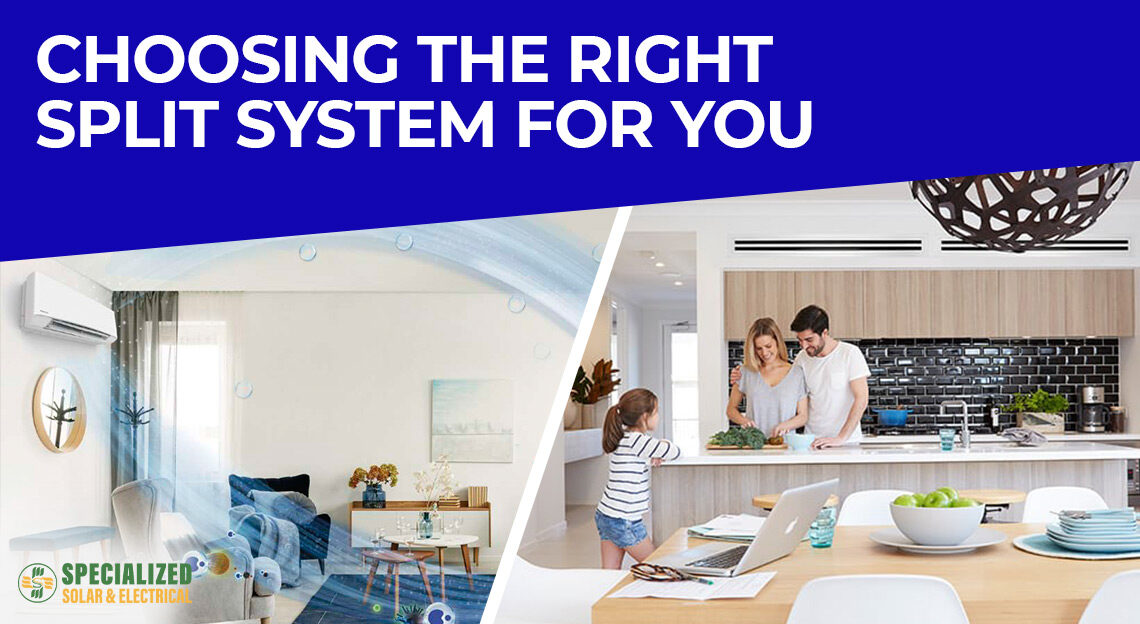You’re in the market for a new split system for your home. But with so many brands to choose between, how do you pick the best split system for your needs?
For starters, you’re on the right track considering split systems for your heating and cooling. Split systems are the cheapest, most energy efficient ways to heat and cool your home according to energy experts1.
This blog provides a 12-point checklist to ensure you get the best split system for your home and your budget.
- Just cooling? Or heating and cooling?
- What type? Split, multi-split, ducted?
- What size? 2kW, 4kW, 8kW?
- Energy rating: How many stars?
- Noise levels
- Control from anywhere
- Energy monitoring
- Home connectivity
- Air purification
- Auto-cleaning
- Smart diagnosis
- Warranty
1. Just cooling? Or heating and cooling?
Split systems are great if you just want to cool your home. But did you know that you can heat your home, as well as cool it, with a reverse-cycle split system? A reverse-cycle split system is the cheapest heating and cooling system to run, the most energy efficient – and it produces the lowest CO2 emissions. Plus, if you team it with solar panels, you can heat and cool your home for free with your own solar energy.
2. What type? Split, multi-split, ducted?
Ducted, split, multi-split – there’s a giddy array of choices when it comes to split systems. Choosing the right type comes down to three factors: the size of the space you need to cool and/or heat, your budget and any physical limitations that could affect installation.
A reverse-cycle split system is the most affordable option, it provides the greatest flexibility – and it’s the most popular type of air conditioner on the market. A reverse-cycle split system is the best choice if you’re looking to heat and cool an open-plan area or one or more rooms. It’s just important to check you have the space inside and directly outside for the unit(s) to be installed. (They need to be installed back to back, with the outside unit on the other side of the wall from the inside unit).
A multi-split system has one outdoor unit and two or more indoor units. They can be a great way to heat and cool two or more rooms that are close together. They do however cost a bit more than a reverse-cycle split system, as ducting is required which adds to the installation cost. But if outside space is an issue and there’s only room for one unit outside, a multi-split could be best option for you.
A ducted reverse-cycle air conditioner provides whole-home heating and cooling. It is the most expensive option as ducting needs to be installed in the walls, ceiling, or floor. However, for larger homes requiring full temperature control in every room, it’s the ideal solution.
3. What size? 2kW, 4kW, 8kW?
The size of split systems is based on power output in kilowatts. Two important things to know about sizing a split system are: don’t undersize, and don’t oversize! Sizing a split system is done based on the space you need to heat and cool. If you oversize it, your split system will use more power than is necessary, and you’ll be wasting money. Likewise, if you undersize it, the split system will struggle to maintain the room at the desired temperature causing it to wear out more quickly.
Here’s a rule of thumb guide to work out the split system size for your space:
- For a room 10m2 to 20m2, a 2.5kW unit should heat and cool the room
- For a room 20m2 to 30m2, a 3.5kW unit should heat and cool the room
- For a room 30m2 to 45m2, a 5 or 6kW unit should heat and cool the room
- For a room 45m2 to 65m2, a 7 or 8kW unit should heat and cool the room
4. Energy rating: How many stars?
Split system’s have efficiency labels with star rating; a blue coloured label for cooling and a red label for heating. The more stars a split system has (on a ten-star scale), the more energy efficient it is. Usually, the higher energy rating of the split system, the higher the purchase price. However, the ongoing lower power costs to run a more energy efficient model should result in greater savings over the life of the system.
5. Noise levels
Check the datasheet to find the sound power level in decibels for the split system model you are considering. Noise levels are particularly important if you’re installing a split system in a bedroom. Look for split systems that have a level of no more than 65 decibels for the outside unit, and a sleep mode on the remote control to ensure that fan is whisper quiet.
6. Control from anywhere
If you like the idea of returning home to a house that’s cool in summer and warm in winter, this feature is for you! You’ll be looking for a split system with built-in Wi-Fi control so you can access and control your heating and cooling with your smartphone even when you’re not at home. Plus, there’s the added benefit for solar owners of being able to use your free solar energy to heat and cool your home when you’re at work – a win/win for the environment and your hip pocket.
7. Energy monitoring
Some of the latest split systems on the market have built-in energy monitoring so you can get a real-time view of energy usage. View your usage on the split system’s LED panel or via an app on your smart phone. It’s a great way to gain an insight into the amount of energy used to heat and cool your home.
8. Home connectivity
Get a split system with home connectivity so you can use your voice to control the temperature in your home. Say ‘Hey Google, turn on my air conditioner’, or ‘Hey Google, increase the temperature to 22 degrees’. How handy would that be!
9. Air purification
Hay fever sufferers will love the air purification feature that comes with better split system brands. Air purification filters out the pollen inside your home and inside the air conditioner itself. It also acts as a deodoriser removing food and cooking odours.
10. Auto-cleaning
The filters inside split systems should be cleaned about twice a year, also the heat exchanger needs regular cleaning to minimise the growth of mould and bacteria. But get a model that has auto-cleaning and the work is done for you!
11. Smart diagnosis
If there’s a fault with your split system, smart diagnosis allows your installer to remotely diagnose the issue. This can save on call-out fees and get your system back up and running in double-quick time.
12. Warranty
Most split systems come with a 5 year product warranty. However better models like LG have a 10-year warranty for the compressor which is a definite plus.
Request a quote
Contact us for an obligation-free quote for a split system that ticks all your boxes. We offer leading brand split systems of all types and sizes for homes and businesses. Plus, as partners of the Specialized Heating & Cooling Group, we have access to the very best prices, so your budget goes further.
1 Sustainability Victoria heating and cooling running costs comparison | web page accessed 29/11/2022














